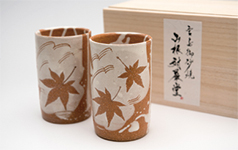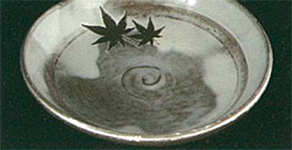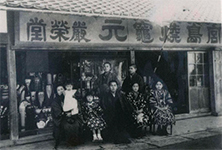Miyajima-yaki[Traditional Crafts designated by Hiroshima Prefecture]YAMANE TAIGENDO / Kawahara Geneido Co., Ltd.

| Exhibitor (Manufacturer) | YAMANE TAIGENDO / Kawahara Geneido Co., Ltd. |
|---|---|
| Address | 1-2-6 Miyajima-guchi, Hatsukaichi City, Hiroshima / 1-5-15 Miyajima-guchi, Hatsukaichi City, Hiroshima |
| TEL | (0829)56-0027 / (0829)56-0238 |
| Job description | Manufacture and sales of Miyajima ware |
The production of “Miyajima-yaki” began in the Edo Era, which is also known as “Osuna ware.” At that time, people in Aki (now Hiroshima) requested a packet of sand under the main hall of Itsukushima Shrine, known as the “God of Safe Travel” as an “amulet” in the hope of a safe journey and return. And the custom of returning the sand and adding sand brought back from one’s journey developed over time, and this custom was called “Osuna-gaeshi.” In the middle of the Edo Era, people began to dedicate ceramic wares manufactured by using the sand. This is said to be the origin of “Osuna ware.” Thereafter, while kilns faced periods of demand and downturns, in the middle of the Meiji Era, the company was established and continues to this day.
A feature of “Miyajima-yaki” is its unique texture as sand is mixed with clay, and the discoloration that occurs with this ceramic ware.


・Enishi momiji pattern cup (blue)
・Enishi momiji pattern shochu cup (yellow)
YAMANE TAIGENDO
“This studio was opened in 1912 by Jusuke Yamane (artist name Kosai Yamane I), on his return to Ono Town after studying and refining his technique at the prestigious Hozan-gama studio in Kyoto. Soon after he was ordered to manufacture ritual utensils for Itsukushima Shrine and received the honor of “Goyo-gama” (Official Kiln) of the Shrine. Now we receive orders widely from customers all over Japan and overseas and in 2009, our product was certified as “The Hiroshima Brand.”



・Tayohai(Multipurpose cups)
・Midori-nagare, Tsuru-kubi, Ichirin-zashi (Green-flow, crane neck, single flower vase)
Kawahara Geneido
In 1909 Tosai I, Kawahara Tomijiro who had received training at “Kyoto Hozan-gama” built a climbing kiln which could sinter ceramics in large quantity and started operations. Since then, the tradition has continued without cessation.
“Keisai-gama” which became independent of “Geneido” was founded by Shigeo, the second son of Tosai I, Tomijiro and has been passed to successive generations ever since.
























